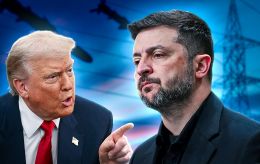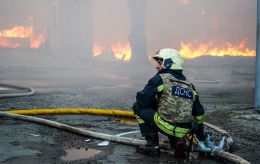What end dates for war in Ukraine does Trump's team mention, and how realistic are they?
 Donald Trump (photo: Getty Images)
Donald Trump (photo: Getty Images)
US President Donald Trump and members of his team have mentioned various timelines for the end of Russia's war against Ukraine – ranging from 24 hours to several months. As the US became increasingly involved in negotiations, these deadlines kept shifting further and further.
RBC-Ukraine reports on the timelines the US is focusing on and the factors influencing progress in the negotiations.
Content
- What end dates for the war were mentioned by Trump's team
- Limited progress on the ceasefire
- Russia's delay tactics
What end dates for the war were mentioned by Trump's team
The current US president and his team have stated that they would like to end Russia's war against Ukraine as quickly as possible. Donald Trump's statement about achieving peace "within 24 hours" – made even before his inauguration – has already turned into a meme and a subject of ridicule.
Soon after, Trump's team began considering months as a timeframe. In December of last year, Trump's special representative for Ukraine, Keith Kellogg, for example, set a 100-day period to find a solution. By February 15, Kellogg's timeline had nearly doubled.
"I live by Trump's time - he asks today, and tomorrow he asks why it hasn't been done yet," Kellogg said. "So I'm publicly setting a 180-day deadline and starting the countdown to ensure all parties are involved."
However, Kellogg's role in negotiations later became secondary. New figures took responsibility for this area – Secretary of State Marco Rubio, National Security Advisor Mike Waltz, and Special Envoy for Russia Steve Witkoff, who accelerated the process.
Currently, there are three closely aligned dates being discussed in the context of the war's end.
In mid-February, according to Bloomberg, the Trump administration informed European officials that it wanted to achieve a ceasefire in Ukraine by Easter – April 20. This same deadline for a ceasefire was publicly proposed by Finland's President, Alexander Stubb, after speaking with Trump.
Earlier, The Economist and the Wall Street Journal reported that the US aimed to conclude a ceasefire agreement within the first 100 days of Trump's presidency – by April 29.
Additionally, Russian President Vladimir Putin has repeatedly stated that he would like to see Trump at the May 9th parade in Moscow, a symbolic date for Russia that could be presented to the Russian public in the context of victory and the war's conclusion.
Limited progress on the ceasefire
The US is indeed making significant efforts to force Russia into a ceasefire, aiming to present this victory to its public. The US became particularly active in mid-March, when Ukrainian and American teams held a meeting in Jeddah. Ukraine supported the US initiative for a 30-day full ceasefire.
However, Russia raised certain objections. This was followed by telephone negotiations between Donald Trump, Vladimir Putin, and Volodymyr Zelenskyy. As a result, the parties agreed only on a partial ceasefire, which would cover the energy and maritime sectors. The details of the agreement were further refined during technical consultations in Riyadh from March 23 to 25. The Ukrainian and Russian delegations did not communicate directly; the Americans acted as intermediaries.
After the negotiations in Riyadh, Trump stated that the United States had observed significant progress in resolving Russia's war against Ukraine. However, he warned that it could still fall apart.
Russia violated the energy ceasefire on March 27. Ukraine raised the issue with the US of monitoring the ongoing ceasefire regime concerning energy. Without this, progress on other aspects of the ceasefire seems unlikely. And there are plenty of such aspects.
Regarding the maritime ceasefire, Russia put forward a series of conditions under which it might be willing to halt hostilities in the Black Sea, including demanding the lifting of certain sanctions. However, this process appears to have stalled for now, as the decision on sanctions rests with Europe, and there has been no indication of willingness from them to act.
A separate issue is the ceasefire regarding strikes on civilian infrastructure. As reported by the Deputy Head of the Ukrainian President's Office, Ihor Zhovkva, Russia refused to discuss this matter during the negotiations in Riyadh. According to him, the Russian delegation stated that they did not have the appropriate mandate, so strikes on Ukrainian cities continue.
Also ahead lies the main and most challenging aspect of the ceasefire – the frontline on the ground. Its parameters, concept, and monitoring mechanisms remain unknown for now.
Russia's delay tactics
Even at the level of US leadership, there is an understanding that the negotiations have become too complex. On March 28, US Secretary of State Marco Rubio noted that it is currently unclear when a peace agreement might be reached.
"We’re going to – we’re trying to achieve peace. We’re committed to trying to achieve peace as long as it takes. That doesn’t mean that I can guarantee you that there’s going to be an agreement in a week or a month. I just can’t put a timeframe on it because it doesn’t depend on us. It depends on the Russians and it depends on the Ukrainians. It also depends on our partners in Europe, who have sanctions that will have to be taken into account, I believe, as part of any final deal," Rubio said during a press briefing.
However, the problem is that Russia is not interested in a quick ceasefire. Although its economy is suffering from sanctions, the Kremlin is likely to have enough resilience to last at least until the end of 2025.
"I am a proponent of the idea that we will be talking about the peace process for a very long time. Because the sole culprit of this war does not want peace. Therefore, it must be forced," stated political scientist and President of the Analytical Center "Politika" Oleh Lisnyi in a comment to RBC-Ukraine.
Currently, setting deadlines puts US President Trump in a weak position, as he is the one more interested in a quick peace. Among other things, this increases the risk that Trump might make concessions to Putin to speed up the process.
"I consider it unconstructive when specific deadlines are set. Because this allows Putin to take advantage of Trump once again. Trump says, 'On the 20th, we'll make some progress.' And Putin says, 'No, I have 2-3 conditions,'" Lisnyi told RBC-Ukraine.
Thus, moving forward, it is crucial for Trump to understand the game Russia is playing and begin using not just carrots but also sticks.
The article includes statements from American, Ukrainian, and Russian politicians, articles from Bloomberg, Reuters, and comments from political scientist Oleh Lisnyi.

